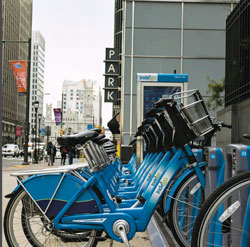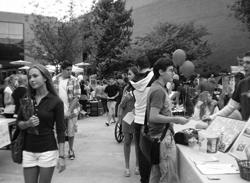It’s no secret that parking is an issue on Monmouth’s campus, and there are several ways this problem has been attempted to be solved.
In New York City, there’s a very popular sharing system of bicycles called, Citi Bikes. There are daily passes or annual memberships, and riders are able to take and return bikes from one of the many different stations and return them to the one closest and most convenient to their destination.
In the city, there are over 10,000 bikes and 600 stations to return the bikes. The purpose of this system is to help go green, promote exercise, and have fun.
A system like this at Monmouth would be helpful, because it’s a way to help eliminate the struggles of parking on campus. There are a few locations around campus that would help give Monmouth the same benefits that Citi Bike gives to New York City.
There could be bikes located on both the academic and resident sides of campus, and also the Bluffs and Pier Village. This would allow almost all students close enough to campus to have the opportunity to skip the drive and ride a bike to get to school.
Dr. Merrily Ervin, Coordinator of School of Science General Education Courses, said, “Bicycling is an excellent form of aerobic exercise. If this program generates interest in the use of bicycles as a mode of transportation that persists after graduation, that could have a very beneficial health impact.”
The use of bikes from closer off-campus apartments or homes would take some pressure off of finding a parking spot that’s close to your class (if you’re lucky), or just a parking spot in general.
Shannon Otten, a senior health studies student, said, “The campus would benefit from a bike service in many different ways. Not only would it help reduce the stress of parking, but it would also be ecofriendly.”
The use of bikes around Monmouth would reduce the amount of cars on or around campus. This would help reduce not only the fuel fumes that release into the air, but also the amount that is purchased to fuel the vehicle itself.
Riding bikes throughout campus would promote exercise. There would not only be the option of Pier Village residents to ride bikes to campus, but on-campus students who don’t have cars would be able to take a short bike ride to the beach.
This feature would be a constant option for students to get off campus without having to rely on a shuttle.
It would also be a lot cheaper and easier for students to ride a bike places off campus instead of renting a Zipcar. Students could enjoy a bike ride and would not have to worry about finding parking, or possibly paying to park when they arrive at their destination.
Stephanie Young, a junior English and secondary education student who lives in the bluffs, said, “I think this system would be really helpful for students who don’t have cars on campus; this way they can travel around the area or to classes whenever they want.”
Having your own bike on campus is always a possibility, but it is harder for some students to store bikes in dorms or having to choose to leave them outside in the unpredictable weather. With the option of a bike sharing system, there would always be a place for the bikes to be stored, and they would withstand any weather conditions.
Christian Esola, Fitness and Wellness Coordinator at Monmouth, said, “There could be tremendous health benefits (depending on just how far you could take these bikes). Say, for example, students could take bikes from their dorms at the University Bluffs over to the main campus, which is approximately 1.5 miles.”
According to the American College Health Association, 56.4 percent of students are not meeting the recommendations of moderate exercise.
With the addition of bikes on campus, students would have the opportunity to use the shared bike system to get exercise outside of the gym, for those who are not particularly fond of running in place.
Esola continued, “Going back and forth even once per day would provide someone with about 20-35 minutes of cardiovascular activity (depending on how fast you were going), which coincides with the minimum recommended amount for general health benefits. Essentially, you could get your ‘workout’ for the day from a program like this.”
Having a shared bike system would be very beneficial to many students, whether they’re on or off campus.
PHOTO COURTESY of Freddie Membrino.




